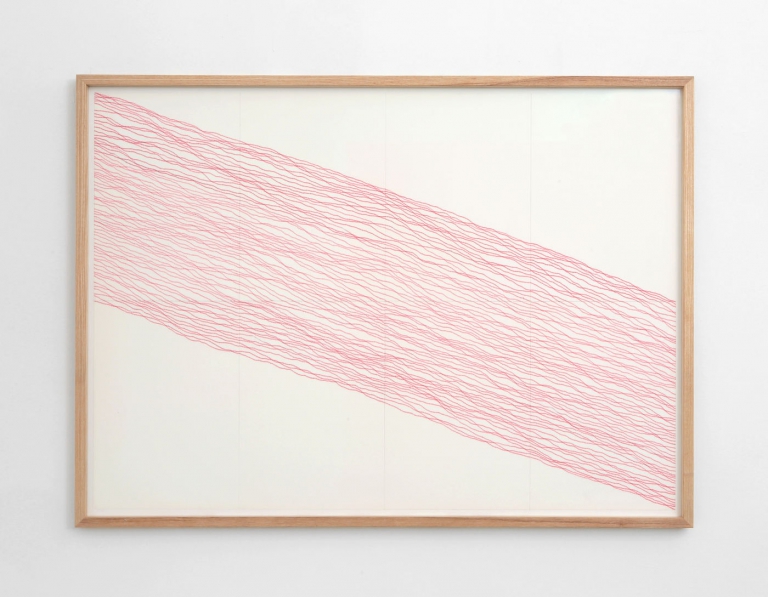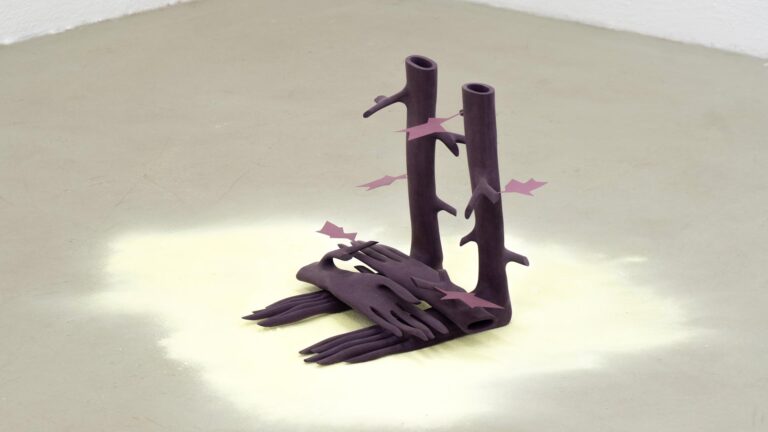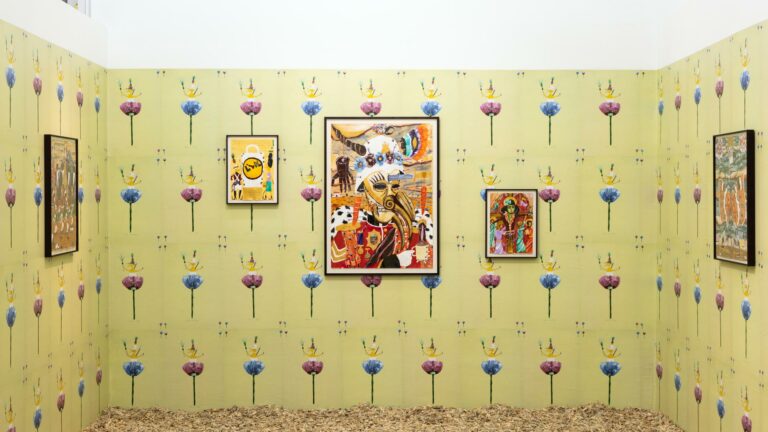Artists: Will Benedict, Rodrigo Hernández, Oliver Husain, Anahita Razmi, Eric Sidner
Exhibition title: Pilger Mills, On untimely forms within the present
Venue: Kunstverein Nürnberg, Nürnberg, Germany
Date: September 9 – November 19, 2017
Photography: Annette Kradisch, all images copyright and courtesy of the artists and Kunstverein Nürnberg
The group exhibition Pilger Mills is concerned with an ambivalent temporal movement – that of progress and innovation, which is repeatedly interrupted by regression or deceleration. Our present age seems to be highly unstable and becomes frequently interrupted by anachronistic processes. We are living with the experience of different thinkable futures, some of which, in light of recent global political developments, appear to be blocked by nationalism and isolation. At the same time, the more promises made to us by the future of technology and networking, the more frightened we become of the existing inequalities and stagnations within our social coexistence as well as within our behavior towards nature.
With the notion “Pilger Mills” this exhibition addresses a range of topics around the movement of forward and backward strides in time. In the literature of dance, the term “pilgrim steps” describes a choreography that follows several steps forward with one or two steps backwards. In literary history, the notion finds expression as an arduous venture in Cervantes’ “Don Quixote” (1605) with his fight against windmills. It likewise appears as a reverse sequence in the perception of history by Lenin, who published his book “One Step Forward, Two Steps Back” in Geneva in May 1904. Furthermore, the term indicates a technical process that applies the rolling of steel tubes through a steady forward and backward motion (“pilger process”).
Against this background the group exhibition focuses an allegorical “processing” of history as well as different contemporary understandings of historicity as such. In their works the artists Will Benedict, Rodrigo Hernández, Oliver Husain, Anahita Razmi and Eric Sidner do not follow linear developments, but allow their observations to intermingle with leaps and folds of time as well as with own interpretations of (art)history. How can the temporal course of our present time be rewritten today? Based on these questions, Pilger Mills also scrutinizes how one can step forwards and backwards without invoking a utopian potential or an inactive stagnation, but employing untimely forms as productive forces instead.
In her artistic practice Anahita Razmi (*1981, Hamburg; lives in Berlin) examines processes of cultural appropriation in which the meanings of existing images, artefacts and thus identities are altered by situating them in another temporal context. In doing so, she often reflects strategies of transfer and structures of perception expressed by the mass media of consumer and pop culture against the background of different value communities between the West and the Middle East.
At the Kunstverein, Razmi presents a conceptual work that was developed last year for the group exhibition “A Heritage Transposed” at Box Freiraum, Berlin. At the time, a presentation of the Tehran Museum of Contemporary Art collection was planned by the Staatliche Museen zu Berlin at the Gemäldegalerie, that had been cancelled later on, due to the denied export license of the artworks from Iran. In her photo collages, Razmi offers an analysis of an iconic work of Minimal Art by Donald Judd that is also part of the Tehran Museum collection. By harnessing the full potential of the material used, Judd sought with his “Untitled (Stacks)” variations (1960 to 1980) to achieve a perfect order of surface and space. In her loan request sent to the Tate Collection in London for Judd’s Version from 1980, Razmi points out that the “Stacks” (1965) at the Tehran Museum were installed at divergent distances and angles and with disturbing architectural elements. In doing so, she critically questions the authority and progressive nature of this postmodern series of works, and to what extent their reception is bound to ideological meaning. Seen through comparative jumps in time and location for a presentday perspective, the history of the object suddenly becomes open to reinterpretation.
Will Benedict (*1978, Los Angeles, USA; lives in Paris) deals with communicative accelerations that connect our world with global processes that are often difficult to fathom. In his exhibition posters, videos and collages he scrutinizes descriptions by the mass media of the environment, climate change and social transformation, and how these are often shaped by political and economic interests.
At the Kunstverein he shows the video “I AM A PROBLEM (T.O.D.D.)” (2016), which he first presented at the 9th Berlin Biennale and which is one of several films created with and for songs by the Detroit noise band, Wolf Eyes. In the form of a music video for the band’s song “T.O.D.D.”, an alien is questioned on immigration issues by the American talk show host, Charlie Rose. The interview is intercut with psychedelic rotations – such as those of the bones from Stanley Kubrick’s “2001: A Space Odyssey” or of the illuminated Eiffel Tower – that further links the anachronistic passages of time with apocalyptic perspectives. The posters on display are from a larger series of offset-print posters that proceed from the context of a public project for the International Biennial of Graphic Art in Ljubljana in 2015. In his photo collages Benedict addresses the internalized perceptions of climate change, assimilation and nutrition. “Stop and Frisk” – the policy of police control measures on the streets – points to the coupling of policies on law and order with economic concerns. “Mutacija” (Slovenian for “Mutation”) references the conflict surrounding the herbicide atrazine developed by the company Syngenta and its campaign to discredit the biologist Tyrone Hayes, who since 1997 has drawn attention to the toxicity of the herbicide for humans and animals.
Eric Sidner (*1985, Houston, USA; lives in Berlin) invokes parallel and contradictory realities in his work, concentrating on the simultaneity of possible future forms and archaic motifs that disrupt our expectations. Repetitive movements such as centrifugal force or material cycles convey the dissolution of boundaries and leaps in time. With the heterogeneous materiality of his sculptures he creates fictional objects that reflect the potential of cultural reshaping as well as its aggressive methods of utilization. In “Pilger Mills” he presents a new work in which hybrid objects come together to create a phantasmagorical figure. Each of its parts is carefully elaborated and tells its own story. A precarious balance between a mental and physical state emerges from the meeting of their various sizes and degrees of reality. Thereby, the objects combine different imaginary and existing laws of gravity, be it the large hat reminiscent of the winged cap from the 1960s U.S. sitcom “The Flying Nun”, the floating movement of an octopus in the sea, or the gravitational forces that keep us tethered to the earth. In “Mouth” (2016) Sidner presents a self-made inflated plastic mouth, similar to those industrially produced for the toy and erotic industries. Powered by a fan the object draws a shimmering, nervous gesture in the space. Following no rational logic, his works, in their baroque opulence, invoke fears of a future marked by exploittation, excessive consumption and the waste of resources in our society.
Oliver Husain (*1969, Frankfurt a. M., lives in Toronto, Canada) draws on references from theatre, dance and animation in the creation of his detailed elaborated filmic works. In his videos, sculptures and installations he often applies seduction tactics common in the mass media, which make the public immediately aware of its role as a spectator and voyeur.
In his film project “Isla Santa Maria 3D”, which was first presented in 2016 at Gallery TPW in Toronto, he makes use of the multiple narrative forms that exist within the genre of science fiction. His 3D video relates the history of imperialism and how it replays into a fictitious future. The film also demonstrates the artist’s individual approach to an emerging film technique whose invasive dimension is already conveyed through its stereoscopic images. In Husain’s filmic installation, viewers become participants of a journey through time that addresses a problematic colonial narrative. In the year 2294, representatives of an alien planet, as well as an oracle that takes the form of a hologram, attempt to gain new knowledge from past reconstructions of the flagship “Santa Maria” in which Columbus sailed to America in 1492. The film returns to America in the late 19th century, where a mythological island supposedly formed from the wreck of a replica of the ship manufactured in 1893 for the World’s Fair in Chicago in honor of Columbus. The hint of crisis in the alien future develops throughout the nonlinear narrative, in which the desire for progress and thus territorial possession repeats along the boundaries of fiction, faith and truth.
Rodrigo Hernández (*1983, Mexico City; lives in Lisbon) traces in his sculptures, drawings, images and spatial settings the search of identity that unfolds between the forms of modernism and alternative, parallel narratives. He is particularly interested in the investigation of futuristic utopias and how these become embedded in art and literature as meta-physical, spiritual or ideological codes.
At the Kunstverein, Hernández presents his new work “Plasma (Dinosaur)”, which builds on his research into the first space missions in the Soviet Union in the mid-20th century and the presentation of their artefacts and documents at the Museum of Cosmonautics in Moscow. Within the structure, similar to an ornamental frieze, a figure is embossed on the surface of metal panels that remind of the outer shell of an airplane or spaceship. As a new figure of “the thinker” – a motif that has occupied a number of artists since the onset of modernity, such as Rodin, Picasso and Brancusi – the outline of the body spreads across the individual surfaces in a pose relaying a sense of reverie as well as nihilism. In her sketched naiveté, the figure reveals diverse cultural influences, such as the reclining figures from Paul Gaugin’s Tahitian beach paintings around 1900. Hernández’s figure conveys an attitude of withdrawal from acceleration, from progress and its conquests, remaining free of expectations in a self-conscious distance. The flexibility of modular forms and the specific colors of the installation imply a kind of allegorical order or measurement offering a way in which steps forward and backwards in time for each individual might be woven into a historical narrative.
Pilger Mills, 2017, exhibition view, Kunstverein Nürnberg
Pilger Mills, 2017, exhibition view, Kunstverein Nürnberg
Anahita Razmi, Stacks / Variations, 2016, Courtesy the artist; Gallery Carbon 12, Dubai
Anahita Razmi, Stacks / Variations, 2016, Courtesy the artist; Gallery Carbon 12, Dubai
Will Benedict, I AM A PROBLEM (T.O.D.D.), 2016, (Filmstill), Courtesy the artist; Balice Hertling, Paris; Neue Alte Brücke, Frankfurt; dépendance, Brussels
Will Benedict, I AM A PROBLEM (T.O.D.D.), 2016, Courtesy the artist; Balice Hertling, Paris; Neue Alte Brücke, Frankfurt; dépendance, Brussels
Will Benedict, I AM A PROBLEM (T.O.D.D.), 2016, Courtesy the artist; Balice Hertling, Paris; Neue Alte Brücke, Frankfurt; dépendance, Brussels
Will Benedict, Murder by Death (poster), 2015; Stop and Frisk (poster), 2013, Courtesy the artist; Balice Hertling, Paris; Neue Alte Brücke, Frankfurt; dépendance, Brussels
Will Benedict, Murder by Death (poster), 2015; Stop and Frisk (poster), 2013, Courtesy the artist; Balice Hertling, Paris; Neue Alte Brücke, Frankfurt; dépendance, Brussels
Eric Sidner, Figure, 2017, Courtesy the artist; Galerie Deborah Schamoni, München
Eric Sidner, Figure, 2017, Courtesy the artist; Galerie Deborah Schamoni, München
Eric Sidner, Figure, 2017, Courtesy the artist; Galerie Deborah Schamoni, München
Eric Sidner, Figure, 2017; Mouth, 2016, Courtesy the artist; Galerie Deborah Schamoni, München
Pilger Mills, 2017, exhibition view, Kunstverein Nürnberg
Oliver Husain, Isla Santa Maria 3D, 2016, the artist, Galerie Marietta Clages, Köln
Oliver Husain, Isla Santa Maria 3D, 2016, Production still, Courtesy the artist, Galerie Marietta Clages, Köln
Oliver Husain, Isla Santa Maria 3D, 2016, Courtesy the artist, Galerie Marietta Clages, Köln
Oliver Husain, Isla Santa Maria 3D, 2016, Courtesy the artist, Galerie Marietta Clages, Köln
Rodrigo Hernández, Plasma (Dinosaur), 2017, Courtesy the artist, Galeria Madragoa, Lisbon
Rodrigo Hernández, Plasma (Dinosaur), 2017, Courtesy the artist, Galeria Madragoa, Lisbon
Rodrigo Hernández, Plasma (Dinosaur), 2017, Courtesy the artist, Galeria Madragoa, Lisbon



























